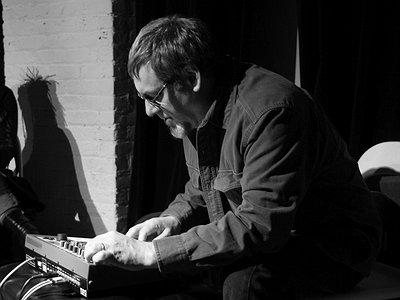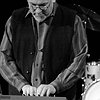Name: Tom Hamilton
Occupation: Composer / Audio Producer
Current Release: City Of Vorticity on Pogus
Musical Recommendations: I want to recommend several musicians whose recorded works are original, satisfying, and well-worth seeking out. They are: Steve Nelson-Raney, Hal Rammel, Thomas Gaudynski, Doug Theriault, Reese Williams, and Eric Richards.
I also want to call attention to guitarist Wallace Hammond, of St. John’s Newfoundland; one of the finest improvisers I’ve ever heard.
When did you start writing/producing music - and what or who were your early passions and influences?
I started by writing some arrangements for jazz groups while I was in high school, and that naturally led to wanting to arrange my own tunes. I took private lessons in music theory while in high school with someone whose passion for musical discovery included jazz and 20th century concert music, and continued on with him while I was in college. So while my jazz interests at the time were very much focused on the post-bop artists of the early sixties, I was also listening to European avant-garde orchestral music. In 1964, my first year of college, I was introduced to electronic music through a lecture given by Vladimir Ussachevsky, which led me to start listening to the prominently recorded electronic composers of that era – Stockhausen, Berio, Davidovsky, Arel, Cage, and Tudor.
For most artists, originality is first preceded by a phase of learning and, often, emulating others. What was this like for you? How would you describe your own development as an artist and the transition towards your own voice?
I would say that it was ALL emulation until one day it just stopped! I did not originally get the idea that being a composer meant constant innovation, even though I was listening to some of the most original people of the era. I’m not even sure that I could call what I was doing then conscious imitation but just sort of learning by working with the material in a manner like the composers I heard in recordings. I was mostly re-applying scraps of information to fit my impression of how things were “supposed” to be done. It was all very naïve.
Like a lot of people who were writing music in college in the 1960s, I became overly concerned with keeping the level of harmonic dissonance as high as possible. I didn’t really have the technical knowledge to pull it off very well, but I liked hearing those sounds. Simultaneously, I was keeping my interest and activities in jazz very separate from those I experienced with new concert music, and I stuck to the mainstream of jazz that was much more about traditional harmonic and rhythmic consonance and dissonance.
By the mid 1970s I had lost interest in composing anything outside of electronic music. I had a studio at Washington University built around some ARP modular analogue synthesizers and several tape recorders. As I experimented more with studio techniques I started to realize that the synthesizer was teaching me about my own musical preferences. Now that was a revelation to me! What I liked (both then and now) was building up layers of similar behaving sound events, then listening to how the voices seemed to interact with each other. I started making pieces that had very fast pacing and short note values – all this at a time when much of the music I was hearing around me started to feel slower and slower. And once I started to connect the dots between all those separate experiences, I was able to pay more attention to how my electronic music might be combined with improvising performers.
What were your main compositional- and production-challenges in the beginning and how have they changed over time?
My early work with electronic music was all about layering sounds. I started with a Sony recorder that had a sound-on-sound feature and then gradually moved into other ways of layering through multiple recorders. At first I thought that it would all work better if I had a multi-track recorder with 16 or 24 tracks. That was quite an expensive item in the 70s, so I had to do it differently. I developed a method where I would accumulate material 4 tracks at a time in my own studio and go to a commercial facility to assemble onto one of those larger machines. I had to give up on the idea of synchronization in the conventional sense, but the loose feel of this collage technique became just a different way of expressing musical time. At first I thought it was a limitation, but then it became a feature. Now I can layer the music on the computer across many tracks, but I still try to keep that loose sync feel that I learned to love in the 70s.
Tell us about your studio, please. What were criteria when setting it up and how does this environment influence the creative process? How important, relatively speaking, are factors like mood, ergonomics, haptics and technology for you?
I’ve worked in home-built studios for maybe 50 years, and I always ask myself: What is the minimum number of primary instruments needed to make the pieces I want, and how are they going to fit into and be accessible in a small amount of space? I like using the same instruments for a long time and not changing unless I really need a new feature that I can’t have with what I already own.
My studio has always had to support two important functions - to be able to produce finished pieces for myself, and to be able to support audio production for a wide variety of other performing artists who come to me to engineer and help produce their recordings.
What are currently some of the most important tools and instruments you're using?
For 17 years now I’ve been making studio pieces and performing live with the original Nord Modular Keyboard. Because it used a “virtual analog” approach to programming sounds, I was able to immediately pick up on techniques that I had developed in the 70s and then just take them further, using a seemingly endless set of functions and interconnection possibilities. In the last several years I’ve also done pieces in Ableton Live, which gives back to me the same level of inspiration that I found initially in the instruments of the 70s. Make sounds, store them, and figure out what to with them afterwards. What could be nicer?
I’ve worked with Pro Tools for over 20 years for capturing and manipulating sounds, as well as for making finished pieces. I also use it in the other part of my life, which is involved with audio production for other contemporary composers and performers. I also use Izotope RX quite a bit in removing blemishes from old and new recordings.
Many contemporary production tools already take over significant parts of what would formerly have constituted compositional work. In which way do certain production tools suggest certain approaches, in which way do they limit and/or expand your own creativity? Are there any promising solutions or set-ups capable of triggering new ideas inside of you as a composer?
An ongoing part of my composing method is to find out what possibilities are inherent in a production tool, and then see if I can “stress the system” to make it go beyond its original intention. Although some people feel that this was easier in the analog past, I find no particular problem in getting computer applications to misbehave. I’m not an intentional “glitcher” but I like to exploit surprises, and I always look for oblique methods for creating the music.
When I started out, everything had to be built by hand. I basically knew what to do and had some experience in practical electronics that started with a childhood interest in amateur radio. I put in my time with the soldering iron, but that was not where my real interest resided. It felt that working on circuit boards was preventing me from producing the music. So I moved in the direction of acquiring pre-built instruments that could be placed into my own context, and learning how to repurpose them for other ideas as they came along.
Nowadays, it seems that the software and hardware people have all given us everything from fundamental building blocks to finished instrument emulations. It’s wonderful to be working in this era, where we can take instruments or parts of instruments and repurpose them for a new use.



